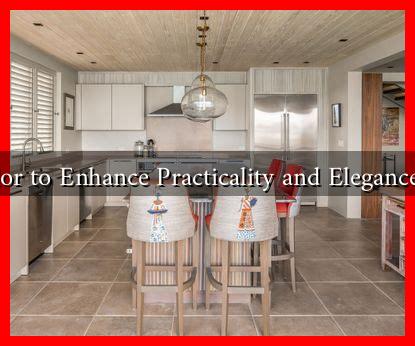-
Table of Contents
How to Use Color to Enhance Practicality and Elegance in the Kitchen
The kitchen is often considered the heart of the home, a space where functionality meets aesthetics. One of the most powerful tools in achieving this balance is color. The right color palette can enhance practicality while also exuding elegance. In this article, we will explore how to effectively use color in your kitchen design to create a space that is both functional and visually appealing.
The Psychology of Color in the Kitchen
Understanding the psychology of color is essential when designing your kitchen. Different colors evoke different emotions and can influence our behavior. Here are some key insights:
- Red: Stimulates appetite and energy, making it a popular choice for dining areas.
- Blue: Known for its calming effects, blue can create a serene cooking environment.
- Yellow: Associated with happiness and warmth, yellow can brighten up a space.
- Green: Represents freshness and health, ideal for kitchens focused on cooking with fresh ingredients.
- Neutral Colors: Whites, grays, and beiges provide a clean backdrop that allows other colors to pop.
Choosing a Color Palette
When selecting a color palette for your kitchen, consider the following factors:
- Size of the Kitchen: Lighter colors can make a small kitchen feel larger, while darker colors can add depth to spacious areas.
- Lighting: Natural light can change how colors appear. Test paint samples in different lighting conditions before making a final decision.
- Existing Elements: Consider the color of your cabinets, countertops, and appliances. Choose complementary colors to create a cohesive look.
Incorporating Color into Kitchen Design
There are various ways to incorporate color into your kitchen design. Here are some effective strategies:
- Cabinetry: Painting cabinets in bold colors like navy blue or forest green can create a stunning focal point.
- Backsplashes: A colorful tile backsplash can add personality and serve as a visual anchor in the kitchen.
- Accent Walls: Consider painting one wall a vibrant color to create contrast and interest.
- Accessories: Use colorful kitchenware, such as pots, pans, and utensils, to add pops of color without committing to a full renovation.
- Textiles: Incorporate colorful dish towels, rugs, and curtains to introduce warmth and texture.
Case Studies: Successful Color Implementations
Several homeowners and designers have successfully used color to enhance both practicality and elegance in their kitchens. Here are a few notable examples:
- Modern Minimalism: A New York City apartment utilized a monochromatic palette of whites and grays, accented with vibrant yellow bar stools. This design maximized space while adding a touch of elegance.
- Rustic Charm: A farmhouse kitchen featured deep green cabinets paired with warm wood tones, creating a cozy yet sophisticated atmosphere.
- Contemporary Chic: A Los Angeles kitchen showcased a bold red island against white cabinetry, making it a striking centerpiece that also encouraged social interaction.
Statistics on Color Impact
Research indicates that color can significantly impact consumer behavior and mood. According to a study by the Institute for Color Research, people make a subconscious judgment about a person, environment, or product within 90 seconds of initial viewing, and between 62% to 90% of that assessment is based on color alone. This highlights the importance of thoughtful color choices in kitchen design.
Conclusion
Incorporating color into your kitchen design is not just about aesthetics; it’s about creating a space that is both practical and elegant. By understanding the psychology of color, choosing the right palette, and implementing thoughtful design strategies, you can transform your kitchen into a vibrant and functional area. Remember to consider the size, lighting, and existing elements of your kitchen when making color choices. With the right approach, your kitchen can become a beautiful and efficient space that reflects your personal style.
For more insights on color psychology and design, you can visit Color Psychology.

